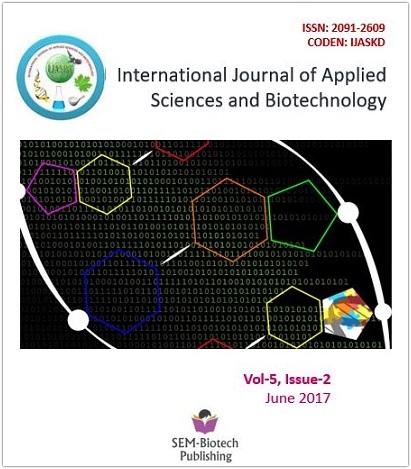Early Mass Diagnosis of Fusarium Wilt in Banana Cultivations using an E-Nose Integrated Autonomous Rover System
DOI:
https://doi.org/10.3126/ijasbt.v5i2.17621Keywords:
Electronic-nose, Artificial Neural Network, Plant disease diagnosis, MOS sensors and Volatile organic compoundsAbstract
Nucleic acid based diagnostics are the standard means for diagnosis of infected plant material. However, these methods are expensive and time-consuming, but they are accurate. On the contrary, disease prediction methods based on Volatile organic compound (VOC) emission from plants are less accurate but, allow for screening of large volumes of samples. This work reports the methodology for development of an inexpensive electronic nose for implementation as early warning systems intended to prevent plant disease outbreaks using VOC pattern analysis. It is proven that plants emit VOCs in response to pathogenic attacks. In this project, efforts were made to register the pattern of VOCs released by the diseased plants. The disease taken for this purpose was Fusarium wilt disease of banana. The E-Nose was successfully fabricated using five MOS sensors connected to a microcontroller, which along with a microSD card module was able to store the acquired VOC data. The VOC data analysis was done in MS-Excel, using NeuroXL Predictor, a neural networking add-in. A small scale banana field containing 35 plants, divided into disease, test and control groups, was established. The disease and test sets were subjected to similar disease induction protocols and VOC data was collected over a period of 40 days. NeuroXL Predictor was trained to recognize odours corresponding to diseases by feeding the neural network with the disease set VOC data. Finally, the training model was validated by providing the test set VOC data to the neural network and the results were found to be accurate. Efforts were made to automate the VOC data acquisition from the plants, as it will be impractical to carry around, a device, through several hectares of plantation. Therefore, a simple autonomous rover was fabricated using DC motors connected to a microcontroller. A DC motor placed on top was used to move the E-nose towards the plants in left and right of the rover. The microcontroller was programmed to stop, move forward and turn the E-nose towards left or right as per the measurements of the field.
Int. J. Appl. Sci. Biotechnol. Vol 5(2): 261-266




